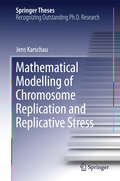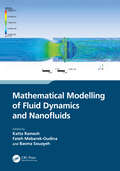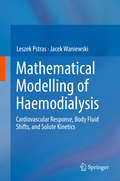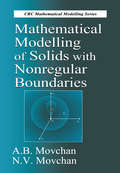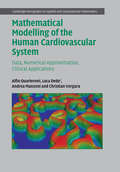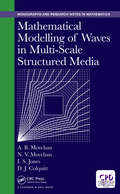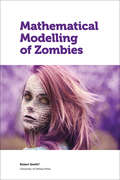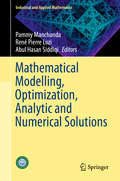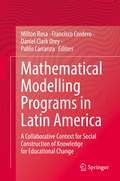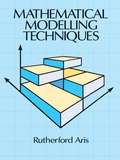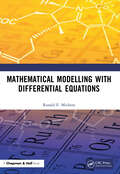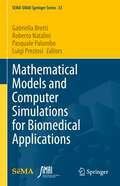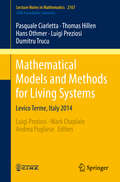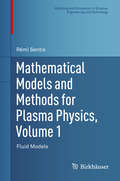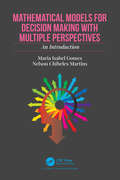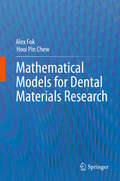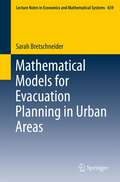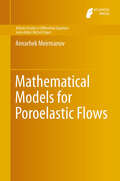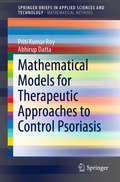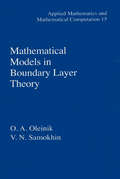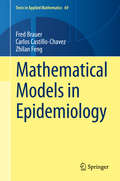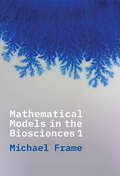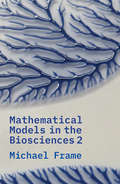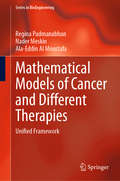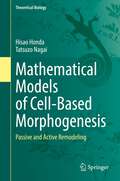- Table View
- List View
Mathematical Modelling of Chromosome Replication and Replicative Stress
by Jens KarschauDNA replication is arguably the most crucial process at work in living cells. It is the mechanism by which organisms pass their genetic information from one generation to the next and life on Earth would be unthinkable without it. Despite the discovery of DNA structure in the 1950s, the mechanism of its replication remains rather elusive. This work makes important contributions to this line of research. In particular, it addresses two key questions in the area of DNA replication: which evolutionary forces drive the positioning of replication origins in the chromosome and how is the spatial organization of replication factories achieved inside the nucleus of a cell?. A cross-disciplinary approach uniting physics and biology is at the heart of this research. Along with experimental support, statistical physics theory produces optimal origin positions and provides a model for replication fork assembly in yeast. Advances made here can potentially further our understanding of disease mechanisms such as the abnormal replication in cancer.
Mathematical Modelling of Fluid Dynamics and Nanofluids
by Katta Ramesh Fateh Mebarek-Oudina Basma SouayehMathematical Modelling of Fluid Dynamics and Nanofluids serves as a comprehensive resource for various aspects of fluid dynamics simulations, nanofluid preparation, and numerical techniques.The book examines the practical implications and real-world applications of various concepts, including nanofluids, magnetohydrodynamics, heat and mass transfer, and radiation. By encompassing these diverse domains, it offers readers a broad perspective on the interconnectedness of these fields.The primary audience for this book includes researchers and graduate students who possess a keen interest in interdisciplinary studies within the realms of fluid dynamics, nanofluids, and biofluids. Its content caters to those who wish to deepen their knowledge and tackle complex problems at the intersection of these disciplines.
Mathematical Modelling of Haemodialysis: Cardiovascular Response, Body Fluid Shifts, and Solute Kinetics
by Leszek Pstras Jacek WaniewskiBeginning with an introduction to kidney function, renal replacement therapies, and an overview of clinical problems associated with haemodialysis, this book explores the principles of the short-term baroreflex regulation of the cardiovascular system and the mechanisms of water and solute transport across the human body from a mathematical model perspective. It synthesizes theoretical physiological concepts and practical aspects of mathematical modelling needed for simulation and quantitative analysis of the haemodynamic response to dialysis therapy.Including an up-to-date review of the literature concerning the modelled physiological mechanisms and processes, the book serves both as an overview of transport and regulatory mechanisms related to the cardiovascular system and body fluids and as a useful reference for the study and development of mathematical models of dynamic physiological processes.Mathematical Modelling of Haemodialysis: Cardiovascular Response, Body Fluid Shifts, and Solute Kinetics is intended for researchers and graduate students in biomedical engineering, physiology, or medicine interested in mathematical modelling of cardiovascular dynamics and fluid and solute transport across the human body, both under physiological conditions and during haemodialysis therapy.
Mathematical Modelling of Solids with Nonregular Boundaries (Mathematical Modeling Ser. #3)
by A.B. Movchan N.V. MovchanMathematical Modelling of Solids with Nonregular Boundaries demonstrates the use of asymptotic methods and other analytical techniques for investigating problems in solid mechanics. Applications to solids with nonregular boundaries are described in detail, providing precise and rigorous treatment of current methods and techniques. The book addresses problems in fracture mechanics of inhomogeneous media and illustrates applications in strength analysis and in geophysics. The rigorous approach allows the reader to explicitly analyze the stress-strain state in continuous media with cavities or inclusions, in composite materials with small defects, and in elastic solids with sharp inclusions. Effective asymptotic procedures for eigenvalue problems in domains with small defects are clearly outlined, and methods for analyzing singularly perturbed boundary value problems are examined.Introductory material is provided in the first chapter of Mathematical Modelling of Solids with Nonregular Boundaries, which presents a survey of relevant and necessary information, including equations of linear elasticity and formulations of the boundary value problems. Background information - in the form of definitions and general solutions - is also provided on elasticity problems in various bounded and unbounded domains. This book is an excellent resource for students, applied scientists, and engineers.
Mathematical Modelling of the Human Cardiovascular System: Data, Numerical Approximation, Clinical Applications (Cambridge Monographs on Applied and Computational Mathematics #33)
by Alfio Quarteroni Luca Dede' Andrea Manzoni Christian VergaraMathematical and numerical modelling of the human cardiovascular system has attracted remarkable research interest due to its intrinsic mathematical difficulty and the increasing impact of cardiovascular diseases worldwide. This book addresses the two principal components of the cardiovascular system: arterial circulation and heart function. It systematically describes all aspects of the problem, stating the basic physical principles, analysing the associated mathematical models that comprise PDE and ODE systems, reviewing sound and efficient numerical methods for their approximation, and simulating both benchmark problems and clinically inspired problems. Mathematical modelling itself imposes tremendous challenges, due to the amazing complexity of the cardiovascular system and the need for computational methods that are stable, reliable and efficient. The final part is devoted to control and inverse problems, including parameter estimation, uncertainty quantification and the development of reduced-order models that are important when solving problems with high complexity, which would otherwise be out of reach.
Mathematical Modelling of Waves in Multi-Scale Structured Media (Chapman & Hall/CRC Monographs and Research Notes in Mathematics)
by Alexander B. Movchan Natasha V. Movchan Ian S. Jones Daniel J. ColquittMathematical Modelling of Waves in Multi-Scale Structured Media presents novel analytical and numerical models of waves in structured elastic media, with emphasis on the asymptotic analysis of phenomena such as dynamic anisotropy, localisation, filtering and polarisation as well as on the modelling of photonic, phononic, and platonic crystals.
Mathematical Modelling of Zombies
by Robert SmithIn this terrible new COVID-19 world, the University of Ottawa is doing its part by offering a 50% discount on this very important book. We decided not to rewrite the witty book description, though we realize it is tone-deaf at the present moment, as we wanted to give readers a sense of the tone of this title. But don’t be deceived: while a fun read, this book will help you better understand how epidemiologists, governments and health care planners use mathematical models to figure out how quickly epidemics and pandemics spread, in order to plan appropriately. Reading has perhaps never been as important, and this book should be at the top of your reading list. You’re outnumbered, in fear for your life, surrounded by flesheating zombies. What can save you now? Mathematics, of course.Mathematical Modelling of Zombies engages the imagination to illustrate the power of mathematical modelling. Using zombies as a “hook,” you’ll learn how mathematics can predict the unpredictable. In order to be prepared for the apocalypse, you’ll need mathematical models, differential equations, statistical estimations, discretetime models, and adaptive strategies for zombie attacks—as well as baseball bats and Dire Straits records (latter two items not included).In Mathematical Modelling of Zombies, Robert Smith? brings together a highly skilled team of contributors to fend off a zombie uprising. You’ll also learn how modelling can advise government policy, how theoretical results can be communicated to a nonmathematical audience and how models can be formulated with only limited information. A forward by Andrew Cartmel—former script editor of Doctor Who, author, zombie fan and all-round famous person in science-fiction circles—even provides a genealogy of the undead. By understanding how to combat zombies, readers will be introduced to a wide variety of modelling techniques that are applicable to other real-world issues (biology, epidemiology, medicine, public health, etc.).So if the zombies turn up, reach for this book. The future of the human race may depend on it.
Mathematical Modelling, Optimization, Analytic and Numerical Solutions (Industrial and Applied Mathematics)
by Abul Hasan Siddiqi Pammy Manchanda René Pierre LoziThis book discusses a variety of topics related to industrial and applied mathematics, focusing on wavelet theory, sampling theorems, inverse problems and their applications, partial differential equations as a model of real-world problems, computational linguistics, mathematical models and methods for meteorology, earth systems, environmental and medical science, and the oil industry. It features papers presented at the International Conference in Conjunction with 14th Biennial Conference of ISIAM, held at Guru Nanak Dev University, Amritsar, India, on 2–4 February 2018. The conference has emerged as an influential forum, bringing together prominent academic scientists, experts from industry, and researchers. The topics discussed include Schrodinger operators, quantum kinetic equations and their application, extensions of fractional integral transforms, electrical impedance tomography, diffuse optical tomography, Galerkin method by using wavelets, a Cauchy problem associated with Korteweg–de Vries equation, and entropy solution for scalar conservation laws. This book motivates and inspires young researchers in the fields of industrial and applied mathematics.
Mathematical Modelling Programs in Latin America: A Collaborative Context for Social Construction of Knowledge for Educational Change
by Milton Rosa Francisco Cordero Daniel Clark Orey Pablo CarranzaThis book is about the unique, sophisticated, and rigorous study of mathematics in Latin America developed over centuries of cultural exchange between Europe, North, and South America. More specifically, the book explores the tradition of mathematical modelling, introduced a century ago. This modelling was adapted to assist members of distinct communities to draw information about their own realities through the elaboration of representations, which generate mathematical knowledge that deals with creativity and invention. The book provides empirical evidence that a category of mathematical modelling developed in Latin America assesses the horizontal and reciprocal relations between mathematics (school/non-school contexts) and the real world. These relations provide an epistemological and ontological change, where mathematical knowledge of the others is recognized on a horizontal plane. Further, they oblige mathematics teachers and students to understand as a community of knowledge that builds their own mathematical categories of their environment governed by the reciprocal relationships between academic knowledge and functional knowledge. The dimensions of the relationships make up a frame of reference that guides educational change in mathematics. The book presents an inquiry-based approach of three Latin American modelling programs: ethnomodelling, transversality of knowledge, and reasoned decision-making. Each one, with its respective theoretical and methodological foundations related to ethnomathematics and mathematical modelling, socioepistemology, and the attribution of meaning to learning. Undoubtedly, the three mathematical modelling programs, independently, provide educational gains, each with its levels of specificity and loyal to its philosophical, theoretical, and methodological principles. However, the book places them together, organized by axes, to define a corpus of mathematical knowledge that envisions profound educational change through the development of different approaches of mathematical modelling. The authors of the 18 chapters in this book, who represent the diversity of Latin America, are from eight countries: Argentina, Brazil, Chile, Colombia, Costa Rica, Cuba, Ecuador, Honduras, and Mexico. They were invited to share their ideas, perspectives, and discuss investigations that represent a rich sample of three Latin American perspectives on mathematical modelling.
Mathematical Modelling Techniques (Dover Books on Computer Science)
by Rutherford Aris"Engaging, elegantly written." -- Applied Mathematical ModellingMathematical modelling is a highly useful methodology designed to enable mathematicians, physicists and other scientists to formulate equations from a given nonmathematical situation. In this elegantly written volume, a distinguished theoretical chemist and engineer sets down helpful rules not only for setting up models but also for solving the mathematical problems they pose and for evaluating models.The author begins with a discussion of the term "model," followed by clearly presented examples of the different types of models (finite, statistical, stochastic, etc.). He then goes on to discuss the formulation of a model and how to manipulate it into its most responsive form. Along the way Dr. Aris develops a delightful list of useful maxims for would-be modellers. In the final chapter he deals not only with the empirical validation of models but also with the comparison of models among themselves, as well as with the extension of a model beyond its original "domain of validity."Filled with numerous examples, this book includes three appendices offering further examples treated in more detail. These concern longitudinal diffusion in a packed bed, the coated tube chromatograph with Taylor diffusion and the stirred tank reactor. Six journal articles, a useful list of references and subject and name indexes complete this indispensable, well-written guide."A most useful, readable-and stimulating-book, to be read both for pleasure and for enlightenment." -- Bulletin of the Institute of Mathematics and Its Applications
Mathematical Modelling with Differential Equations
by Ronald E. MickensMathematical Modelling with Differential Equations aims to introduce various strategies for modelling systems using differential equations. Some of these methodologies are elementary and quite direct to comprehend and apply while others are complex in nature and require thoughtful, deep contemplation. Many topics discussed in the chapter do not appear in any of the standard textbooks and this provides users an opportunity to consider a more general set of interesting systems that can be modelled. For example, the book investigates the evolution of a "toy universe," discusses why "alternate futures" exists in classical physics, constructs approximate solutions to the famous Thomas—Fermi equation using only algebra and elementary calculus, and examines the importance of "truly nonlinear" and oscillating systems. Features Introduces, defines, and illustrates the concept of "dynamic consistency" as the foundation of modelling. Can be used as the basis of an upper-level undergraduate course on general procedures for mathematical modelling using differential equations. Discusses the issue of dimensional analysis and continually demonstrates its value for both the construction and analysis of mathematical modelling.
Mathematical Models and Computer Simulations for Biomedical Applications (SEMA SIMAI Springer Series #33)
by Gabriella Bretti Roberto Natalini Pasquale Palumbo Luigi PreziosiMathematical modelling and computer simulations are playing a crucial role in the solution of the complex problems arising in the field of biomedical sciences and provide a support to clinical and experimental practices in an interdisciplinary framework.Indeed, the development of mathematical models and efficient numerical simulation tools is of key importance when dealing with such applications.Moreover, since the parameters in biomedical models have peculiar scientific interpretations and their values are often unknown, accurate estimation techniques need to be developed for parameter identification against the measured data of observed phenomena. In the light of the new challenges brought by the biomedical applications, computational mathematics paves the way for the validation of the mathematical models and the investigation of control problems.The volume hosts high-quality selected contributions containing original research results as well as comprehensive papers and survey articles including prospective discussion focusing on some topical biomedical problems. It is addressed, but not limited to: research institutes, academia, and pharmaceutical industries.
Mathematical Models and Methods for Living Systems
by Andrea Pugliese Mark Chaplain Dumitru Truculuigi Preziosi Luigi Preziosi Hans Othmer Thomas Hillen Pasquale CiarlettaThe aim of these lecture notes is to give an introduction to several mathematical models and methods that can be used to describe the behaviour of living systems. This emerging field of application intrinsically requires the handling of phenomena occurring at different spatial scales and hence the use of multiscale methods. Modelling and simulating the mechanisms that cells use to move, self-organise and develop in tissues is not only fundamental to an understanding of embryonic development, but is also relevant in tissue engineering and in other environmental and industrial processes involving the growth and homeostasis of biological systems. Growth and organization processes are also important in many tissue degeneration and regeneration processes, such as tumour growth, tissue vascularization, heart and muscle functionality, and cardio-vascular diseases.
Mathematical Models and Methods for Plasma Physics, Volume 1
by Rémi SentisThis monograph is dedicated to the derivation and analysis of fluid models occurring in plasma physics. It focuses on models involving quasi-neutrality approximation, problems related to laser propagation in a plasma, and coupling plasma waves and electromagnetic waves. Applied mathematicians will find a stimulating introduction to the world of plasma physics and a few open problems that are mathematically rich. Physicists who may be overwhelmed by the abundance of models and uncertain of their underlying assumptions will find basic mathematical properties of the related systems of partial differential equations. A planned second volume will be devoted to kinetic models. First and foremost, this book mathematically derives certain common fluid models from more general models. Although some of these derivations may be well known to physicists, it is important to highlight the assumptions underlying the derivations and to realize that some seemingly simple approximations turn out to be more complicated than they look. Such approximations are justified using asymptotic analysis wherever possible. Furthermore, efficient simulations of multi-dimensional models require precise statements of the related systems of partial differential equations along with appropriate boundary conditions. Some mathematical properties of these systems are presented which offer hints to those using numerical methods, although numerics is not the primary focus of the book.
Mathematical Models for Decision Making with Multiple Perspectives: An Introduction
by Maria Isabel Gomes Nelson Chibeles MartinsThis book brings together, in a single volume, the fields of multicriteria decision making and multiobjective optimization that are traditionally covered separately. Both fields have in common the presence of multiple perspectives of looking at and evaluating decisions to be taken but they differ in the number of available alternatives. Multicriteria approaches deal with decision processes where a finite number of alternatives have to be evaluated while, in multiobjective optimization, this number is infinite and the space of alternatives continuous. This book is written for students of applied mathematics, engineering, and economics and management, with no assumed previous knowledge on the subject, as well as for practitioners in industry looking for techniques to support decision making. The mathematical formalism is very low, so that all materials are accessible to most readers. Nonetheless, a rich bibliography allows interested readers to access more technical literature. The textbook is organized in eleven chapters, each corresponding to a class of about two hours. A comprehensive set of examples is presented, allowing for a didactic approach when presenting the methodologies. Each chapter ends with exercises that are designed to develop problem-solving skills and to promote concepts retention.
Mathematical Models for Dental Materials Research
by Alex Fok Hooi Pin ChewThis book presents a mechanistic approach—mathematical modeling—for carrying out dental materials research. This approach allows researchers to go beyond the null hypothesis and obtain a solution that is more general and therefore predictive for conditions other than those considered in a study. Hence it can be used either on its own or to complement the commonly used statistical approach. Through a series of practical problems with wide-ranging application, the reader will be guided on:How to construct a mathematical model for the behavior of dental materials by making informed assumptions of the physical, chemical, or mechanical situationHow to simplify the model by making suitable simplificationsHow to calibrate the model by calculating the values of key parameters using experimental resultsHow to refine the model when there are discrepancies between predictions and experimentsOnly elementary calculus is required to follow the examples and all the problems can be solved by using MS Excel© spreadsheets.This is an ideal book for dental materials researchers without a strong mathematical background who are interested in applying a more mechanistic approach to their research to give deeper insight into the problem at hand. Advance praise for Mathematical Models for Dental Materials Research:“This is a nice addition for research students on how to conduct their work and how to manage data analysis. It brings together a number of important aspects of dental materials investigations which has been missing in the literature. The practical examples make it much easier to understand.” – Michael F. Burrow, Clinical Professor in Prosthodontics, The University of Hong Kong“The great strengths of this volume are the real world examples of dental materials research in the successive chapters. In turn, this is an outcome of the outstanding expertise of both authors. I warmly recommend this book to the dental biomaterials community worldwide.” – David C. Watts, Professor of Biomaterials Science, University of Manchester, UK
Mathematical Models for Evacuation Planning in Urban Areas
by Sarah BretschneiderDisasters like floods, hurricanes, chemical or nuclear accidents may cause the necessity to evacuate the affected area. The evacuation of the urban area needs to be planned carefully. One issue is the reorganization of the traffic routing. Congested urban areas have usually complex street networks that are composed of many intersections with streets connecting them. The population density of a congested urban area is usually high and the street network is already used to capacity during rush hour traffic. The considered problem of this work is the reorganization of the traffic routing of an urban area for the case of an emergency mass evacuation. Especially aspects of the evacuation like safety, avoidance of delays and the total system travel time are taken into account. Combinatorial and graph theoretical aspects are adapted for the evacuation problem and highlight issues concerning especially conflicts within intersections. This work gives an extensive summary of literature of evacuation of urban areas. Mixed-integer linear programming models are developed for evacuation problems and heuristic algorithms are provided and tested.?
Mathematical Models for Poroelastic Flows
by Anvarbek MeirmanovThe book is devoted to rigorous derivation of macroscopic mathematical models as a homogenization of exact mathematical models at the microscopic level. The idea is quite natural: one first must describe the joint motion of the elastic skeleton and the fluid in pores at the microscopic level by means of classical continuum mechanics, and then use homogenization to find appropriate approximation models (homogenized equations). The Navier-Stokes equations still hold at this scale of the pore size in the order of 5 - 15 microns. Thus, as we have mentioned above, the macroscopic mathematical models obtained are still within the limits of physical applicability. These mathematical models describe different physical processes of liquid filtration and acoustics in poroelastic media, such as isothermal or non-isothermal filtration, hydraulic shock, isothermal or non-isothermal acoustics, diffusion-convection, filtration and acoustics in composite media or in porous fractured reservoirs. Our research is based upon the Nguetseng two-scale convergent method.
Mathematical Models for Therapeutic Approaches to Control Psoriasis (SpringerBriefs in Applied Sciences and Technology)
by Priti Kumar Roy Abhirup DattaThis book discusses several mathematical models highlighting the disease dynamics of psoriasis and its control. It explains the control of keratinocyte concentration through a negative feedback mechanism and the effect of including a realistic time delay in that system. The effect of cytokine release is described in a mathematical model of psoriasis and further elucidated in two different mathematical pathways: the ordinary differential equation model system, and the fractional-order differential equation model system. The book also identifies the role of CD8+ T-cells in psoriasis by investigating the interaction between dendritic cells and CD8+ T-cells. Presenting an approach to control the fractional-order system to prevent excess production of keratinocyte cell population, the book is intended for researchers and scientists in the field of applied mathematics, health informatics, applied statistics and qualitative public health, as well as bio-mathematicians interested in the mathematical modeling of autoimmune diseases like psoriasis.
Mathematical Models in Boundary Layer Theory (Applied Mathematics Ser. #15)
by V.N. SamokhinSince Prandtl first suggested it in 1904, boundary layer theory has become a fundamental aspect of fluid dynamics. Although a vast literature exists for theoretical and experimental aspects of the theory, for the most part, mathematical studies can be found only in separate, scattered articles. Mathematical Models in Boundary Layer Theory offers the first systematic exposition of the mathematical methods and main results of the theory.Beginning with the basics, the authors detail the techniques and results that reveal the nature of the equations that govern the flow within boundary layers and ultimately describe the laws underlying the motion of fluids with small viscosity. They investigate the questions of existence and uniqueness of solutions, the stability of solutions with respect to perturbations, and the qualitative behavior of solutions and their asymptotics. Of particular importance for applications, they present methods for an approximate solution of the Prandtl system and a subsequent evaluation of the rate of convergence of the approximations to the exact solution. Written by the world's foremost experts on the subject, Mathematical Models in Boundary Layer Theory provides the opportunity to explore its mathematical studies and their importance to the nonlinear theory of viscous and electrically conducting flows, the theory of heat and mass transfer, and the dynamics of reactive and muliphase media. With the theory's importance to a wide variety of applications, applied mathematicians-especially those in fluid dynamics-along with engineers of aeronautical and ship design will undoubtedly welcome this authoritative, state-of-the-art treatise.
Mathematical Models in Epidemiology (Texts in Applied Mathematics #69)
by Carlos Castillo-Chavez Fred Brauer Zhilan FengThe book is a comprehensive, self-contained introduction to the mathematical modeling and analysis of disease transmission models. It includes (i) an introduction to the main concepts of compartmental models including models with heterogeneous mixing of individuals and models for vector-transmitted diseases, (ii) a detailed analysis of models for important specific diseases, including tuberculosis, HIV/AIDS, influenza, Ebola virus disease, malaria, dengue fever and the Zika virus, (iii) an introduction to more advanced mathematical topics, including age structure, spatial structure, and mobility, and (iv) some challenges and opportunities for the future.There are exercises of varying degrees of difficulty, and projects leading to new research directions. For the benefit of public health professionals whose contact with mathematics may not be recent, there is an appendix covering the necessary mathematical background. There are indications which sections require a strong mathematical background so that the book can be useful for both mathematical modelers and public health professionals.
Mathematical Models in the Biosciences I
by Michael FrameAn award-winning professor’s introduction to essential concepts of calculus and mathematical modeling for students in the biosciences This is the first of a two-part series exploring essential concepts of calculus in the context of biological systems. Michael Frame covers essential ideas and theories of basic calculus and probability while providing examples of how they apply to subjects like chemotherapy and tumor growth, chemical diffusion, allometric scaling, predator-prey relations, and nerve impulses. Based on the author’s calculus class at Yale University, the book makes concepts of calculus more relatable for science majors and premedical students.
Mathematical Models in the Biosciences II
by Michael FrameVolume Two of an award-winning professor&’s introduction to essential concepts of calculus and mathematical modeling for students in the biosciences This is the second of a two-part series exploring essential concepts of calculus in the context of biological systems. Building on the essential ideas and theories of basic calculus taught in Mathematical Models in the Biosciences I, this book focuses on epidemiological models, mathematical foundations of virus and antiviral dynamics, ion channel models and cardiac arrhythmias, vector calculus and applications, and evolutionary models of disease. It also develops differential equations and stochastic models of many biomedical processes, as well as virus dynamics, the Clancy-Rudy model to determine the genetic basis of cardiac arrhythmias, and a sketch of some systems biology. Based on the author&’s calculus class at Yale, the book makes concepts of calculus less abstract and more relatable for science majors and premedical students.
Mathematical Models of Cancer and Different Therapies: Unified Framework (Series in BioEngineering)
by Regina Padmanabhan Nader Meskin Ala-Eddin Al MoustafaThis book provides a unified framework for various currently available mathematical models that are used to analyze progression and regression in cancer development, and to predict its dynamics with respect to therapeutic interventions. Accurate and reliable model representations of cancer dynamics are milestones in the field of cancer research. Mathematical modeling approaches are becoming increasingly common in cancer research, as these quantitative approaches can help to validate hypotheses concerning cancer dynamics and thus elucidate the complexly interlaced mechanisms involved. Even though the related conceptual and technical information is growing at an exponential rate, the application of said information and realization of useful healthcare devices are lagging behind.In order to remedy this discrepancy, more interdisciplinary research works and course curricula need to be introduced in academic, industrial, and clinical organizations alike. To that end, this book reformulates most of the existing mathematical models as special cases of a general model, allowing readers to easily get an overall idea of cancer dynamics and its modeling. Moreover, the book will help bridge the gap between biologists and engineers, as it brings together cancer dynamics, the main steps involved in mathematical modeling, and control strategies developed for cancer management. This also allows readers in both medical and engineering fields to compare and contrast all the therapy-based models developed to date using a single source, and to identify unexplored research directions.
Mathematical Models of Cell-Based Morphogenesis: Passive and Active Remodeling (Theoretical Biology)
by Hisao Honda Tatsuzo NagaiThis book describes the shape formation of living organisms using mathematical models. Genes are deeply related to the shape of living organisms, and elucidation of a pathway of shape formation from genes is one of the fundamental problems in biology. Mathematical cell models are indispensable tools to elucidate this problem. The book introduces two mathematical cell models, the cell center model and the vertex model, with their applications. The cell center model is applied to elucidate the formation of neat cell arrangements in epidermis, cell patterns consisting of heterogeneous-sized cells, capillary networks, and the branching patterns of blood vessels. The vertex model is applied to elucidate the wound healing mechanisms of the epithelium and ordered pattern formation involving apoptosis. Pattern formation with differential cell adhesion is also described. The vertex model is then extended from a two-dimensional (2D) to a three-dimensional (3D) model. A cell aggregate involving a large cavity is described to explain the development of the mammalian blastocyst or the formation of an epithelial vesicle. Epithelial tissues and the polarity formation process of the epithelium are also explained. The vertex model also recapitulates active remodeling of tissues and describes the twisting of tissue that contributes to understanding the cardiac loop formation of the embryonic tube. The book showcases that mathematical cell models are indispensable tools to understand the shape formation of living organisms. Successful contribution of the mathematical cell models means that the remodeling of collective cells is self-construction. Examining the successive iterations of self-constructions leads to understanding the remarkable and mysterious morphogenesis that occurs during the development of living organisms. The intended readers of this book are not only theoretical or mathematical biologists, but also experimental and general biologists, including undergraduate and postgraduate students who are interested in the relationship between genes and morphogenesis.
